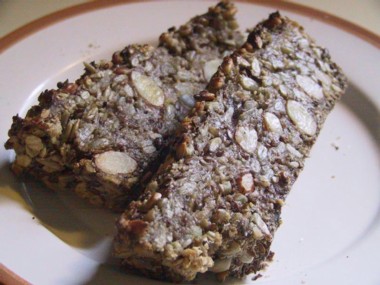If somebody offered you a nice pile of birdseed and nuts with a Metamucil chaser, you probably wouldn’t expect the phrase “life changing” to come up. Like a lot of things, though, those very same ingredients, if put together the right way, equal something quite different.
The dish in question has percolated here and there on the Internet for a while, but its origin by most accounts is the food blog of Sarah Britton, a Canadian-trained holistic nutritionist now living in Copenhagen, Denmark. Britton, in turn, got the recipe from a friend. The name she gave it is grandiose: “the Life-Changing Loaf of Bread.”
Definitely a case of over-promising—if you want to change lives, invent the self-brewing coffee bean or retractable grass. Still, worth a try. There is some viability to the “life-changing” moniker, though, especially if you want to avoid wheat. That’s where Metamucil enters the picture. The important ingredient of that and other fiber supplements is psyllium seed husk. Psyllium may be a reliable way to keep yourself trotting to the W.C. with regularity, but it has another intriguing and useful quality: it retains water like a champion (i.e., the husks swell up to cartoonish size). That means it’s a highly useful binding agent in the absence of wheat gluten.
The Life-Changing Loaf employs psyllium seed husks (whole or powdered) in just that way, so the recipe involves no wheat. The rest of it—and substitutions for everything except the psyllium are workable—includes hazelnuts (or almonds), chia seed, flax seed, rolled oats, sunflower seeds, maple syrup, melted ghee (clarified butter) or coconut oil, salt and water. The dry ingredients get stirred in a loaf pan, then the liquid goes in. A little more stirring, and it’s left for two to 24 hours to soak. An hour or so in the oven yields the finished product.
When everything gets stirred up, the result is a sticky brick that looks more like suet than bread. It seems impossible that the glop in question could yield something that falls into the same category as, say, a baguette. Persevere, and you get a really hot brick—little seems to have changed, though it exudes a compelling, buttery and nutty toastiness.
The instructions include an adamant warning: don’t cut into your loaf until it’s totally cooled. Presumably, that’s because you need sufficient sturdiness to allow for cutting through whole nuts. This is no retiring lightweight of a loaf. You may need a friend (or a winch) to help pick it up and begin the earnest sawing. Lumberjack your way to a slice, and the cross-section is rather beautiful, a complex arrangement of all those nuts and seeds suspended in gray and brown.
Bite in, and you’ll get a surprise. It may be wheatless and vegan (with coconut oil, at least), but the loaf offers moist density and hearty crunchiness. Its taste is a savory combo of nut and butter. The only wheat-based breads it brings to mind are the dark, rich, and seedy varieties found in the northern end of Europe. This is substantial stuff, a loaf of bread with which you could brain somebody and eat the evidence.
Toast this bread, and it becomes something remarkable, crunchier on the outside and chewy on the inside. Butter it up, and you may well entertain the possibility of your life changing. This isn’t a bread for a traditional sandwich—it’s not particularly tall, and its density and robust flavors are better as the main focus. It is, on the other hand, a meal in itself. A couple of slices is more than sufficient as a breakfast. (And in case you’re wondering, all that psyllium, divided as it is among individual slices, doesn’t seem to prompt anything too sudden.)
Bread probably can’t change your life unless you’re a baker with an existential crisis. But this loaf can certainly change your perspective. It’s bread turbocharged into something that’s remarkably healthy, and the taste is memorable, addictive even.
If you’d like to give it a try, you’ll find the full recipe at mynewroots.org/site/2013/02/the-life-changing-loaf-of-bread/.•



